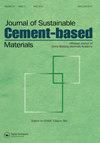Comparison of stearic acid and oleic acid for shrinkage-mitigating of alkali-activated slag composites
IF 4.2
3区 工程技术
Q1 CONSTRUCTION & BUILDING TECHNOLOGY
Journal of Sustainable Cement-Based Materials
Pub Date : 2023-11-14
DOI:10.1080/21650373.2023.2280915
引用次数: 0
Abstract
AbstractThe large drying shrinkage is one of the most serious factors limiting the practical application of alkali-activated slag concrete (AASC). In this study, based on the successful shrinkage reduction of waste cooking oil for alkali-activated slag paste (AASP), the influence of stearic acid (saturated fatty acids) and oleic acid (unsaturated fatty acids) on fresh properties (setting time and fluidity), physical characteristics (density and water absorption), mechanical strengths (flexural strength and compressive strength), and durability (drying shrinkage, self-shrinkage, and carbonation resistance) are systematically compared. The experimental results reveal that admixing stearic acid and oleic acid can effectively inhibit the drying shrinkage and self-shrinkage of the AASP. Specifically, adding 1 wt% stearic acid (oleic acid) can reduce the drying shrinkage of the AASP by 20% (25%) and self-shrinkage by 32% (55%), respectively. Remarkably, the combined usage of the two additives can maximize the performance of the AASP, such as obtaining satisfactory mechanical strengths, extending the initial setting time, and improving the carbonation resistance. The developed AASP can be regarded as a low-cost and environmentally-friendly product, which can promote practical applications of AASC.Keywords: alkali-activated slag concrete (AASC)stearic acidoleic acidshrinkage Disclosure statementThe authors declare that they have no known competing financial interests or personal relationships that could have appeared to influence the work reported in this paper.Additional informationFundingThis work was supported by Jilin Province Department of Education, Scientific Research Project (grant number: JJKH20230626KJ). This work was also supported by Doctoral Starting up Foundation of Yanbian University, College of Geography and Ocean Sciences (grant number: ydbq202223).硬脂酸与油酸对碱活性渣复合材料减缩性能的比较
摘要干燥收缩大是制约碱渣混凝土实际应用的重要因素之一。本研究在成功还原废食用油制备碱活性渣浆(AASP)的基础上,系统比较了硬脂酸(饱和脂肪酸)和油酸(不饱和脂肪酸)对渣浆新鲜性能(凝结时间和流动性)、物理特性(密度和吸水性)、机械强度(抗折强度和抗压强度)和耐久性(干燥收缩率、自收缩率和抗碳酸化性能)的影响。实验结果表明,硬脂酸和油酸的掺入能有效抑制AASP的干燥收缩和自收缩。具体来说,添加1 wt%硬脂酸(油酸)可以使AASP的干燥收缩率分别降低20%(25%)和32%(55%)。值得注意的是,两种添加剂的联合使用可以最大限度地提高AASP的性能,如获得满意的机械强度,延长初凝时间,提高抗碳化性能。开发的AASP是一种低成本、环保的产品,可以促进AASP的实际应用。关键词:碱活化矿渣混凝土(AASC)硬脂酸油酸收缩披露声明作者声明,他们没有已知的竞争经济利益或个人关系,可能会影响本文所报道的工作。经费资助:吉林省教育厅科研项目(批准号:JJKH20230626KJ)。延边大学地理与海洋科学学院博士创业基金(批准号:ydbq202223)资助。
本文章由计算机程序翻译,如有差异,请以英文原文为准。
求助全文
约1分钟内获得全文
求助全文
来源期刊
CiteScore
6.60
自引率
15.90%
发文量
71
期刊介绍:
The Journal of Sustainable Cement-Based Materials aims to publish theoretical and applied researches on materials, products and structures that incorporate cement. The journal is a forum for discussion of research on manufacture, hydration and performance of cement-based materials; novel experimental techniques; the latest analytical and modelling methods; the examination and the diagnosis of real cement and concrete structures; and the potential for improved cement-based materials. The journal welcomes original research papers, major reviews, rapid communications and selected conference papers. The Journal of Sustainable Cement-Based Materials covers a wide range of topics within its subject category, including but are not limited to: • raw materials and manufacture of cement • mixing, rheology and hydration • admixtures • structural characteristics and performance of cement-based materials • characterisation techniques and modeling • use of fibre in cement based-materials • degradation and repair of cement-based materials • novel testing techniques and applications • waste management

 求助内容:
求助内容: 应助结果提醒方式:
应助结果提醒方式:


